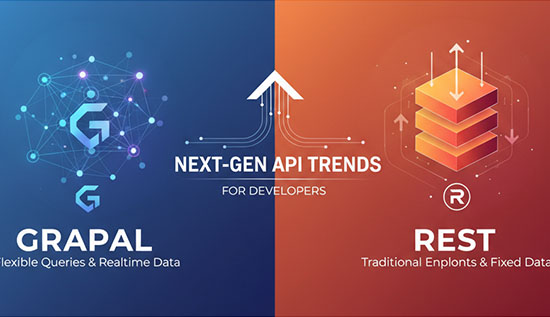Enterprise Containerization Trends with Docker & Kubernetes

Powerful insights into containerization trends, Docker and Kubernetes shifts, enterprise scaling strategies and cloud-native solutions shaping 2025.
As time has gone on, containerization has gone from being a handy tool for developers to a must-have for businesses. The main idea behind containers is now used by big companies around the world in financial services, health care, retail, logistics, telecommunications and manufacturing.
In 2025, enterprise container adoption is experiencing its fastest growth ever, driven by the rise of distributed systems, multicloud infrastructure and the expansion of microservices-based architectures. As companies modernize legacy applications and build cloud-native environments, two platforms continue to lead the movement: Docker and Kubernetes.
These three things work together to make current DevOps lifecycles possible. They allow for faster deployments, better scalability and better use of infrastructure resources. These platforms also shape the direction of Containerization trends, influencing how enterprises design, ship, secure and scale software.
This article explores the most critical enterprise containerization trends, highlights the Docker trends 2025 shaping IT operations, analyzes Kubernetes adoption trends and covers Container orchestration best practices that leading organizations follow.
You will also see how Cloud-native container solutions are redesigning DevOps pipelines, learn about effective container deployment strategies and understand How Docker and Kubernetes are changing DevOps. Finally, we will also examine Docker container security tips and trends and practical insights on how to scale microservices with Kubernetes.
This complete guide helps leaders, architects and developers get ready by giving them real-life examples, business use cases and step-by-step implementation guides and engineers to navigate the latest containerization trends for enterprises in 2025 and beyond.
As enterprises shift toward cloud-first architecture, Containerization trends have become a driving force in modernization initiatives. The core appeal of containers lies in their lightweight, portable and consistent runtime environments. They stop dependencies from clashing, allow automatic growth and make DevOps teams more productive.
More than 85% of businesses will run some or all of their production jobs in containers by 2025. This will make containerization a standard rather than an innovative concept.
The Rise of Enterprise Containerization Trends
As enterprises shift toward cloud-first architecture, Containerization trends have become a driving force in modernization initiatives. Containers are popular because they are small, easy to move and have uniform runtime environments.
They stop dependencies from clashing, allow automatic growth and make DevOps teams more productive. By 2025, more than 85% of enterprises run some or all of their production workloads in containers making containerization a default standard rather than an innovation.
1. Why Containerization Trends Are Accelerating in 2025
Several forces are contributing to the rapid growth of Containerization trends across enterprise environments:
- Cloud migration continues to accelerate, pushing organizations to re-architect legacy applications using containers.
- Remote and distributed teams rely heavily on standardized development workflows, and containers ensure consistency across environments.
- Microservices architecture is becoming mainstream and containers provide the modular foundation needed.
- DevOps and automation continue to evolve, making container-based CI/CD pipelines the preferred approach.
These factors collectively elevate containers from a technical preference to a core enterprise strategy. Meanwhile, Docker and Kubernetes for enterprises continue to dominate adoption, setting industry standards and shaping the latest containerization trends for enterprises.
2. Docker Trends 2025 Shaping the Future of Containerization
One of the major forces behind enterprise container usage is Docker. Even as Kubernetes takes over orchestration, Docker remains the most preferred tool for building, packaging and managing container images.
Key Docker trends 2025 include:
- Docker Compose is now widely adopted in enterprise prototyping, allowing teams to simulate multi-container microservice environments locally.
- Docker BuildKit enhancements, improving image build speed and caching.
- Rootless Docker adoption, addressing security and compliance requirements.
- Integration with AI/ML workflows, enabling faster dependency management and environment setup.
Example:
- A fintech company modernizing its payment gateway uses Docker to containerize legacy services, rapidly improving environment consistency.
- A healthcare analytics provider uses Docker images for reproducible machine learning pipelines.
These Docker trends 2025 show how enterprises use Docker beyond traditional app packaging, extending into automation, AI and internal developer platforms.
3. Kubernetes Adoption Trends Shaping Enterprise Scaling
As the de facto standard for orchestration, Kubernetes continues to define how enterprises scale applications. Kubernetes adoption trends reflect the demand for reliability and automation.
Key trends include:
- Multi-cloud Kubernetes clusters becoming standard, as companies seek vendor neutrality.
- Kubernetes-native security platforms such as Falco and Kyverno rising in popularity.
- Enterprise managed Kubernetes services like EKS, AKS, and GKE exceeding 70% adoption.
- GitOps expanding as the operational model, supported by Kubernetes’ declarative philosophy.
Use Case Examples:
- Telecom providers use Kubernetes to dynamically scale streaming infrastructure and handle millions of concurrent sessions.
- Retail enterprises use Kubernetes autoscaling to support seasonal traffic bursts during holiday shopping campaigns.
4. Container Orchestration Best Practices in 2025
With the rise of distributed systems, enterprises follow standardized methods to streamline orchestration:
- Use declarative manifests for predictable deployments.
- Implement GitOps for version-controlled infrastructure.
- Automate load balancing using Kubernetes Services and Ingress.
- Implement RBAC and audit logs for secure cluster access.
- Use liveness/readiness probes for dynamic health monitoring.
These Container orchestration best practices help enterprises maximize performance and reliability while aligning with modern DevOps models.
In summary, Containerization trends in 2025 highlight a global shift toward automation, cloud-native design, high scalability and strong security requirements. Both Docker and Kubernetes continue to dominate enterprise adoption, each shaping the future of cloud-native infrastructure.
Cloud-Native Solutions, Deployment Strategies & DevOps Evolution
As cloud ecosystems mature, enterprises increasingly adopt Cloud-native container solutions to achieve faster delivery, high resilience and flexible scaling. Microservices, declarative infrastructure and immutable applications are all cloud-native ideas that are built on top of containers. These cloud-native architectures continue shaping Containerization trends across industries.
1. Cloud-Native Container Solutions Leading Enterprise Modernization
Businesses use stacks that are built around containers and are cloud-native because:
- Scalability: It only takes seconds to copy a container.
- Fault tolerance: Kubernetes instantly fixes containers that aren't working right.
- Environment consistency: makes sure that development, staging, and production all behave the same.
- Cost optimization: containers make the best use of resources.
Real Examples:
- Logistics companies use cloud-native Kubernetes clusters to route real-time delivery data and process shipping events.
- Banks run containerized digital banking platforms to reduce downtime and accelerate feature updates.
These implementations demonstrate the power of Cloud-native container solutions as a driver of enterprise agility.
2. Container Deployment Strategies for Modern Enterprises
Enterprises no longer use monolithic deployment methods. Instead, they embrace advanced Container deployment strategies such as:
- Blue/Green Deployments: Two production environments run simultaneously for zero-downtime release switching.
- Canary Releases: New versions are rolled out to a small portion of users first.
- Rolling Updates: Pods update gradually, ensuring ongoing availability.
- A/B Testing: Different versions serve different user groups for analytics-driven decision-making.
Step-by-Step Example: Rolling Updates with Kubernetes
- Create a Deployment with the new container image.
- Configure maxSurge and maxUnavailable for safe scaling.
- Apply the manifest via kubectl or CI/CD pipeline.
- Kubernetes gradually replaces old Pods with new ones.
- Monitor health checks and resource usage.
These strategies form a critical part of modern Containerization trends, helping enterprises reduce risk and accelerate release cycles.
3. How Docker and Kubernetes Are Changing DevOps Culture
One of the most impactful shifts in technology today is How Docker and Kubernetes are changing DevOps. Traditional DevOps is evolving into platform engineering, automation-driven pipelines and GitOps operations.
Key transformations include:
- Docker standardizes work environments, which cuts down on bugs that come from setups that aren't always the same.
- Kubernetes imposes declarative infrastructure, which lets DevOps teams automate tasks that they used to do by hand.
- Container processes work great with Infrastructure-as-Code, GitOps and automated testing pipelines.
For example, a business SaaS provider uses Kubernetes deployments, Docker images, and ArgoCD to make releases that are fully automated and don't need any human input. As DevOps teams get better at automating tasks, these changes will continue to shape Containerization trends.
4. Latest Containerization Trends for Enterprises in 2025
Several latest containerization trends for enterprises will dominate 2025:
- Serverless containers (Cloud Run, AWS Fargate) for instant scalability.
- AI/ML model serving inside containers, driven by demand for reproducible environments.
- Service mesh integration (Istio, Linkerd) for granular traffic control.
- Edge computing containers, running on IoT devices and on-premise gateways.
These new developments show that containerization is being used for more than just web services. It is also being used for a wide range of business tasks.
Enterprise Security Trends, Best Practices & Kubernetes Scaling
Security remains one of the top priorities influencing Containerization trends. As businesses scale their container environments, they encounter new risks, attack vectors and compliance demands. This section analyzes security-focused enterprise strategies, including Docker container security tips and trends, as well as practical insights into how to scale microservices with Kubernetes.
1. Docker Container Security Tips and Trends for 2025
Security is central to container adoption, and Docker container security tips and trends continue to evolve rapidly.
Key security priorities include:
- Scanning container images for vulnerabilities using tools like Trivy or Clair.
- Signing images with Docker Notary to prevent unauthorized modifications.
- Using minimal base images like Alpine to reduce attack surface.
- Rootless Docker becoming an enterprise standard.
- Runtime security tools monitoring anomalous container behavior.
Real Security Example: A financial company had a breach because of an old picture. A lot fewer incidents happened after automated scanning and Docker file signing were added. This shows why Docker container security tips and trends are important for making a company more resilient.
2. Kubernetes Security Enhancements in Enterprise Environments
As part of Kubernetes adoption trends, enterprises implement advanced protection strategies:
- Enforced RBAC permissions
- Pod Security Admission (formerly PSPs)
- Secrets encryption using KMS providers
- Network segmentation using Kubernetes NetworkPolicies
- Audit logs for compliance reporting
Example Use Case: Hospitals deploying patient management systems use Kubernetes NetworkPolicies to isolate workloads handling medical data.
These approaches enhance enterprise trust in Kubernetes as a secure orchestration platform.
3. How to Scale Microservices with Kubernetes
A critical area shaping modern cloud architecture is how to scale microservices with Kubernetes. Kubernetes offers built-in scaling mechanisms that increase performance while reducing cost.
Key methods include:
- Horizontal Pod Autoscaling (HPA): Automatically increases or decreases pods based on CPU, memory or custom metrics.
- Vertical Pod Autoscaling (VPA): Adjusts container resources dynamically.
- Cluster Autoscaler: Adds or removes worker nodes based on workload.
- Service Mesh Scaling: Improves inter-service communication efficiency.
Practical Example: An e-commerce enterprise experiencing Black Friday traffic uses HPA and Cluster Autoscaler to handle traffic spikes seamlessly an ideal demonstration of how to scale microservices with Kubernetes.
4. Scaling Microservices: Step-by-Step Guide
Step-by-step approach on how to scale microservices with Kubernetes:
- Containerize microservices using Docker.
- Create Kubernetes Deployment manifests with resource limits.
- Enable HPA using metric-server.
- Set custom metrics via Prometheus if needed.
- Configure Cluster Autoscaler on cloud-managed Kubernetes.
- Continuously test scaling through load simulations.
These capabilities reinforce why scaling is a core driver of Containerization trends across enterprise operations.
Real-World Use Cases, Future Predictions & Enterprise Strategy
As Containerization trends continue to change, businesses use the technology for changes that are essential to their operations. In the last part, we look at real-life enterprise use cases, predictions about the future and strategic suggestions for CIOs, architects and DevOps leaders.
1. Real-World Enterprise Use Cases of Docker & Kubernetes
- Financial Services and Banking: Banks use Kubernetes groups to find fraud in real time and build mobile banking systems that can grow as needed. Docker protects app settings so they can't be changed.
- E-Commerce and Retail: Kubernetes makes it easy for stores to scale up or down when shopping times are busy. To make sure they are always available, inventory systems, payment platforms and choosing engines are all put in their own containers.
- Telecommunications: Kubernetes clusters that have been native to the cloud are used by telecom providers for establishing upward 5G services across edge environments.
- Healthcare: To meet safety standards, hospitals run clinical software in safeguarded Docker containers.
These use cases show the versatility of Docker and Kubernetes for enterprises, reshaping how modern organizations operate.
2. Future Predictions: Where Containerization Is Heading by 2030
Future Containerization trends likely to dominate business strategies include:
- AI-driven container orchestration, optimizing deployments automatically.
- Zero-trust security for containers is becoming required in all fields.
- Decentralized databases for containers that are run by blockchain.
- Complete automation of CI/CD processes, so no one has to do anything.
- Containers that work in both quantum and hybrid computer settings.
3. Strategic Recommendations for Modern Enterprises
Executives and IT teams should:
- Adopt Cloud-native container solutions for long-term agility.
- Implement Kubernetes to standardize the launch of microservices.
- Put money into platform engineering in order to render DevOps processes more centralized.
- Use container security tools to set upward strong control.
- Teach teams how to make use of Kubernetes, GitOps and observability as tools.
Following these recommendations can help businesses stay competitive as Containerization trends continue accelerating.
Conclusion
The rapid rise of containerization trends has reshaped how modern enterprises build, deploy, and scale applications. As businesses progress toward becoming cloud-native, Docker and Kubernetes continue to be the strongest instruments available for building reliable, self-sufficient and rapid infrastructure.
Insights from Docker trends 2025 highlight major enhancements in developer workflows, image security and enterprise-focused automation, while Kubernetes adoption trends demonstrate how multi-cloud orchestration, GitOps, platform engineering and self-managed scale are all growing stronger. These technologies collaborate to give businesses the adaptability and speed that they need to thrive in today's competitive and rapidly evolving online environment.
The ability to scale large workloads efficiently supported by proven methods on how to scale microservices with Kubernetes allows companies to optimize performance and manage costs more effectively. At the same time, evolving Docker container security tips and trends guide organizations toward stronger governance, more secure pipelines and hardened production environments that meet modern compliance standards.
Ultimately, Docker and Kubernetes for enterprises are no longer optional they are critical. By embracing the latest containerization trends for enterprises, companies gain faster deployments, higher reliability, improved automation and the agility required for future growth.
The innovations shaping container platforms today will continue driving enterprise modernization, enabling teams to create scalable, secure and future-ready systems that keep pace with global digital demands.
Read More: Wi-Fi 7 in Enterprises: Adoption, Benefits & Deployment
More Articles
 25 Nov 2025
25 Nov 2025
Coding Bootcamps for iGaming Developers | Learn Game Dev
Coding bootcamps for iGaming developers offer a fast path into game creation, guiding beginners and professionals toward real casino-grade coding skills.
 24 Nov 2025
24 Nov 2025
Responsible Gaming Tools | Player Protection Solutions
Protect players and enhance integrity with next-gen Responsible Gaming Tools. Learn how to implement responsible gambling solutions that promote safety, fairness, and control.
 24 Nov 2025
24 Nov 2025
Increase User Engagement with Cross-Platform Strategies
Learn cross-platform engagement strategies to strengthen consistency and boost user interaction across all digital channels.
 20 Nov 2025
20 Nov 2025
GraphQL vs REST: Next-Gen API Trends for Developers
Compare GraphQL vs REST to optimize API performance, scalability and modern application design with best practices for developers.